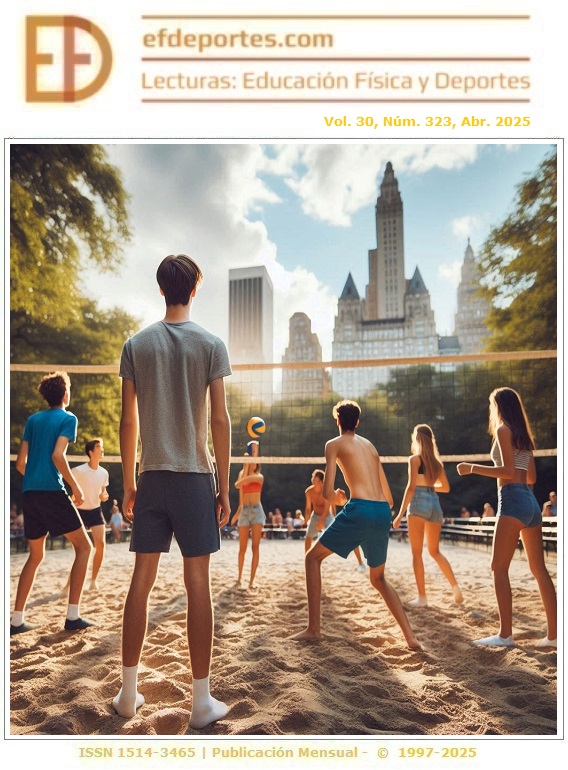Effects of Individualized Strength-Speed Training on the Power of Two Young Soccer Players
A Case Study
Abstract
Both strength and speed are physical abilities that have been partially analyzed by working them separately, however, Power reflects the relationship between Force and Speed (P = F x V) which recognizes the amount of force generated in an activity where there is a speed. The relationship of Force-speed (F-V) and Power-speed (P-V), underpin the Force-Power-Speed profiles, characterized by the maximum mechanical capacities of the neuromuscular system of the lower limbs in various sports. This study focuses on soccer, where homogeneity in training is reflected, assuming that its athletes have the same conditions; a situation that does not favor the development and individual potential of each soccer player; therefore. The main objective of the research is to describe the effect of an individualized training plan, based on explosive strength (Strength-Speed) on the power of soccer players. A quantitative approach is used, with case study guidelines, with a sample of two young Chilean soccer players, who participated in individualized training plans; concluding that individualized work obtains benefits at levels of strength, contraction speed and greater muscular power, since the positive increase in the power levels of both young Chilean soccer players participating in the study is evident, thus favoring relevant qualities in this sport discipline. The results obtained contribute to the achievement of greater displacement (sprint) at the time of competing, reaching greater muscle tension and speed in them.
References
Ashidiq, M.O., Sabarini, S.S., Riyadi, S., Hidayatullah, M.F., y Doewes, M. (2024). The difference of the effects of regular strength and core strength training programs on the biomechanics of football long pass judging from eye-foot coordination. Revista iberoamericana de psicología del ejercicio y el deporte, 19(3), 303-312. https://dialnet.unirioja.es/servlet/articulo?codigo=9675087
Babiloni-López, C., Úbeda-Pastor, V., y Llana-Belloch, S. (2022). El perfil fuerza-velocidad en salto y sprint. Una revisión narrativa. Revista Digital de Educación Física, 13(74). https://dialnet.unirioja.es/servlet/articulo?codigo=8213127
Beltrán, J., y Duglio, M. (2020). Análisis de los perfiles de fuerza-velocidad y potencia-velocidad en jugadores profesionales de fútbol [Tesis de Licenciatura. Instituto Universitario Asociación Cristiana de Jóvenes]. http://hdl.handle.net/20.500.12729/469
Bernal, J., y Díaz, J. (2020). Propuesta metodológica para la enseñanza de la técnica de salto, basado en un programa de entrenamiento pliométrico de fuerza explosiva del tren inferior, en deportistas de 14 años del Club Deportivo Maracaneiros [Tesis de Licenciatura en Deporte. Universidad Pedagógica Nacional de Bogotá]. http://hdl.handle.net/20.500.12209/12986
Cubillos, A. (2018). Propuesta de entrenamiento de fuerza explosiva en karate-do [Tesis de Licenciatura en Educación Física y Deportes. Universidad del Valle]. https://hdl.handle.net/10893/20622
Del Águila, A. (2015). Análisis de los cambios de dirección en fútbol tras un entrenamiento de fuerza basado en el perfil fuerza-velocidad [Tesis de Máster. Universidad Católica San Antonio]. https://goldepenalti.com/wp-content/uploads/2016/01/An%C3%A1lisis-de-los-cambios-de-direcci%C3%B3n-en-f%C3%BAtbol-tras-un-entrenamiento-de-fuerza-basado-en-el-perfil-Fuerza.velocidad.pdf
Fédération Internationale de Football Association (2023). Fútbol Femenino. Encuesta a las Federaciones Miembro 2023. Fifa-Strasse 20. https://digitalhub.fifa.com/m/6973d06842598476/original/Futbol-femenino-encuesta-a-las-federaciones-miembro-2023.pdf
Fernández-Galván, L.M., Casado, A., y Domínguez, R. (2024). Evaluación y prescripción del salto vertical y horizontal en futbolistas. Revisión narrativa (Assessment and prescription of vertical and horizontal jumping in soccer players. Narrative review). Retos, 52, 410-420. https://doi.org/10.47197/retos.v52.101834
Giráldez, J. (2017). Determinación del perfil fuerza-velocidad mediante un test de saltos con dos cargas (protocolo de dos cargas) [Trabajo de fin de Máster en Rendimiento Físico y Deportivo. Centro de Estudios de Postgrado, Universidad Pablo de Olavide]. http://dx.doi.org/10.13140/RG.2.2.13891.22569
González-Badillo, J.J. (2014). Consideraciones sobre la Manifestación y el Desarrollo de la Fuerza y la Potencia Muscular. PubliCE. https://journal.onlineeducation.center/api-oas/v1/articles/sa-x57cfb271893a7/export-pdf/consideraciones-sobre-la-manifestacion-y-el-desarrollo-de-la-fuerza-y-la-potencia-muscular-799
González-Badillo, JJ., y Ribas, J. (2002). Bases de la programación del entrenamiento de fuerza. INDE Publicaciones.
González-Badillo, J.J., y Ribas, J. (2018). Programación del entrenamiento de fuerza (p. 11,17). INDE Publicaciones.
González-Conde, A., González-Devesa, D., Suárez-Iglesias, D., y Ayán, C. (2022). The validity and reliability of a portable device (ADR-Jumping) to estimate vertical jump performance. Proceedings of the Institution of Mechanical Engineers, Part P, https://doi.org/10.1177/17543371221127079
Guntoro, T.S., y Nurhidayah, D. (2024). Validity of The U21 Men's Soccer Physical Test Battery. Multilateral: Jurnal Pendidikan Jasmani dan Olahraga, 23(2), 140-150. https://dx.doi.org/10.20527/multilateral.v23i2.18952
Heinecke, M., Wesley, N., y Mayhew, J. (2024). Comparison of On-Campus and Off-Campus Summer Training on Strength Performance of College Football Players. International Journal of Strength and Conditioning, 4(1). https://doi.org/10.47206/ijsc.v4i1.269
Lopez-Torres, O., Fernandez-Elias, V.E., Li, J., Gomez-Ruano, M.A., y Guadalupe-Grau, A. (2022). Validity and Reliability of A New Low-Cost Linear Position Transducer to Measure Mean Propulsive Velocity: The ADR device. Proceedings of the Institution of Mechanical Engineers, Part P, 0(0). https://doi.org/10.1177/17543371221104345
Maneiro, N. (15.04.2023). Como anda a evolução do futebol na América do Sul? EFDeportes.com. https://m.efdeportes.com/articulo.php?id=576
Morocho, C. (2021). La relación fuerza-velocidad para la optimización del entrenamiento y prevención de lesiones. Revista Cienciadigital, 5(1), 51-72. https://doi.org/10.33262/cienciadigital.v5i1.1462
Mustafa, G., Khan, W., Arif, T., y Latif, H. (2024). Effects of resistance and strength training on serum phosphorus levels in male footballers: implications for physical educators and sports trainers. Pedagogy of Physical Culture and Sports, 28(5), 378-386. http://dx.doi.org/10.15561/26649837.2024.0506
National Strength and Conditioning Association (2018). El desarrollo de la potencia. Ejercicios, programas y protocolos. Ediciones Tutor.
Peña Gónzalez, I., Sarabia, J.M., y Moya-Ramón, M. (2022). Young soccer players aggrupation for conditioning trainings according toplayers’ maturation and physical performance: A practical example. Retos, 43, 98-106. https://doi.org/10.47197/retos.v43i0.88580
Pérez, C. (2013). Metodología y valoración del entrenamiento de la fuerza. https://es.slideshare.net/slideshow/metodologia-y-valoracion-de-la-fuerza/26811265
Sierra, A. (2014). Capacidades físicas. https://angielisbeths5.blogspot.com/
Tavares, R., Casimiro, G., Pinto, J., Valente, L., Pinheiro, B., Ramos, G., Moreira, R. y Souza, R. (2022). Analysis of vertical jump, rating of perceived exertion, delayed-onset muscle soreness, and muscular peak power in young male Brazilian football players submitted to plyometric and semi-squat training with weights. Retos, 46, 613-621. https://doi.org/10.47197/retos.v46.94085
Yıldırım, S., y Akyüz, Ö. (2024). Compound Antrenmanlarının Futbolcularda Addüktör, Abdüktör Kas Kuvveti ve Rasyosuna Etkisi. Sportive, 7(2), 308-318. https://doi.org/10.53025/sportive.1544025
Copyright (c) 2025 Lecturas: Educación Física y Deportes

This work is licensed under a Creative Commons Attribution-NonCommercial-NoDerivatives 4.0 International License.









